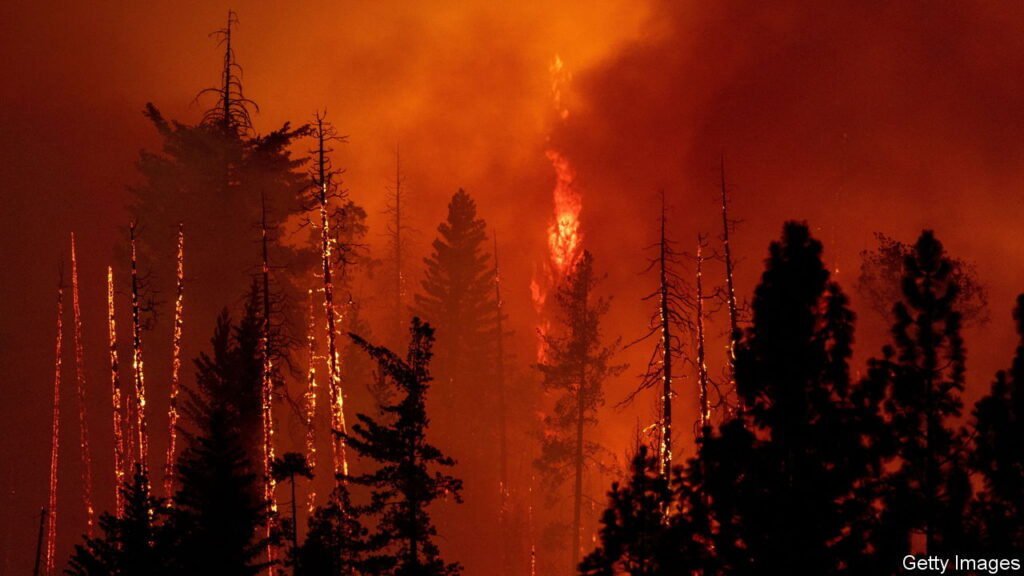ON FEBRUARY 8TH the Copernicus Climate Change Service, an EU agency, announced that in the 12 months to January 31st the world’s temperature had been, on average, 1.52°C higher than pre-industrial levels. The Paris agreement, a climate treaty of 2015, committed countries to keep the rise in “global average temperature…well below 2°C above pre-industrial levels” and seek to limit it to 1.5°C. Can people say that the world has surpassed one of the Paris milestones? If it has not, what would be needed to make such a claim?
The Paris numbers, particularly the lower target, have become totemic. Yet the agreement does not precisely define its thresholds or when they will be passed. This mattered less when the world was still a good way from the first milestone—in 2015 the world was just 1°C warmer than pre-industrial levels. But that is no longer the case. And it may come as a surprise that the 1.5°C and 2°C thresholds are quite tricky to define.
The first problem is what constitutes “pre-industrial levels”. Technically, this could refer to any period before the industrial revolution. The Intergovernmental Panel on Climate Change (IPCC), whose reports are approved by governments and therefore provide a scientific framework for global climate policy, uses the average temperature for 1850-1900. But even that leaves room for fuzziness: there were no reliable instrumental records in that period. Scientists have to rely on approximations. The climate datasets of agencies around the world all do this differently. Because each uses a different starting point for the 1.5°C clock, they differ in what they consider the average temperature rise to have been in any year (see chart 1). Copernicus and most other institutions that take an interest found 2023 to be a bit below 1.5°C, but those at a research group called Berkeley Earth found it to be over the line.
The second difficulty is defining how the “global average temperature” is to be measured, and the timeframe for doing so. Is the average calculated over a day? A year? Several years? Temperatures have been exceeding the 1.5°C threshold over single days for roughly a decade (see chart 2) and their seasonal fluctuations make single days a poor indicator of long-term warming. More weight is given to yearly averages, but even those do not solve all problems. Annual averages vary enormously based on the 12-month window they cover. In January, for instance, when Copernicus released its annual analysis of 2023 temperatures it found that the year was on average 1.48°C warmer than pre-industrial. The agency noted that shifting the 12-month window slightly, to account for what was anticipated to be an unusually warm January, might tip that average over 1.5°C. That is exactly what transpired . Moreover, forces other than greenhouse-gas emissions also cause global average annual temperatures to rise and fall from one year to the next. The multi-annual cycle of El Niño and La Niña offers one of the largest nudges, cooling temperatures in La Niña years and pushing them up during El Niño ones (see chart 3).
If a single year is not a good indicator for passing the 1.5°C threshold, then what time period should be used? Article 4 of the Paris agreement refers to the 1.5°C and 2°C thresholds as a “long-term temperature goal”. The IPCC uses a 20-year average. But that approach is of little use to policymakers. It means that by the time Earth’s climate can be confirmed to have passed the 1.5°C Paris milestone, it will be in the rear-view mirror.
The world need not wait that long. The long-term residence of greenhouse gases in the atmosphere (molecules of carbon dioxide in particular stay aloft and unchanged for centuries) means that so long as there is a net flow of these gases into the atmosphere they will accumulate and temperatures will continue to rise. If the average for the past decade is 1.5°C or above and greenhouse-gas concentrations are not falling, it should not be necessary to wait another ten years to say that the Paris target has been exceeded.
Researchers are proposing alternative measures on that basis. In an article in Nature, a journal, published in December 2023, a group from the UK Met Office proposed that, rather than looking at two decades of historical data, the 20-year window should use the current year as its middle point. One decade would come from past data, the other from projections for the following ten years. Applying their approach to the end of 2022, the researchers found that the 20-year average was 1.26°C warmer than pre-industrial levels. But the number came with error bars, largely due to the unforeseeable nature of natural variations in the climate in the second decade—things like El Niño and large volcanic eruptions which can temporarily push temperatures up or down. The temperature rise could be as low as 1.13°C or as high as 1.43°C, the team said.
Another option which would not require years of historical data—but does not meet the IPCC’s requirement for a 20-year average— would be to smooth the annual ups and downs of global temperatures into a trendline and look at when that passes the 1.5°C threshold (see chart 4).
None of these solutions is perfect. But as the first Paris threshold gets ever closer and questions are raised about what should be required from governments after it is crossed, resolving the complexities has become a pressing matter. ■
For more coverage of climate change, sign up for The Climate Issue, our fortnightly subscriber-only newsletter, or visit our climate-change hub.
